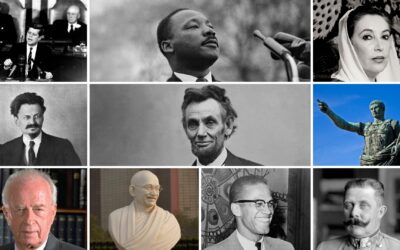Once upon a time, there lived a young boy in Rome, Italy, named Enrico Fermi. Born on September 29, 1901, his humble beginnings gave no hint of the giant he would become in the world of physics.
During his early years, Fermi was a curious child with an insatiable thirst for knowledge. This attribute quickly set him apart from his peers. It was at the tender age of 14 that a tragic event would take place that propelled Fermi into the world of physics. Following the death of his older brother, Fermi found solace in books, specifically, a set of books about physics and mathematics, which served as a springboard into a lifelong fascination with these subjects.
In the pursuit of his academic interests, Fermi enrolled at the University of Pisa through a scholarship at the age of 17. Despite the rigid curriculum, Fermi’s aptitude for self-learning proved invaluable. He published his first scientific work in 1921, titled “On the Dynamics of a Rigid System with Two Degrees of Freedom”, and graduated in 1922, laying a strong foundation for his future contributions to the world of physics.
In 1926, Fermi made a significant breakthrough by introducing the statistical laws, now known as Fermi-Dirac statistics, which describe a system of particles that obey the Pauli exclusion principle. This marked one of his most remarkable contributions to quantum theory.
In the years that followed, Fermi’s reputation grew, and he made significant contributions to the development of quantum theory, nuclear and particle physics, and statistical mechanics. By the early 1930s, he was known as one of the world’s most accomplished physicists.
The year 1938 was a significant one in Fermi’s life. He was awarded the Nobel Prize in Physics “for his demonstrations of the existence of new radioactive elements produced by neutron irradiation, and for his related discovery of nuclear reactions brought about by slow neutrons.” The timing of the prize was fortuitous; it allowed Fermi, who was of Jewish descent, and his family to leave Fascist Italy amidst the intensifying persecution of Jews.
Fermi emigrated to the United States, where he began working at Columbia University. It was here that he conducted his most significant work. In the depths of the graphite pile under the bleachers of Stagg Field at the University of Chicago, Fermi and his team achieved the first controlled nuclear chain reaction on December 2, 1942. This experiment, known as Chicago Pile-1, marked the beginning of the Atomic Age.
During World War II, Fermi became instrumental in the development of the atomic bomb under the Manhattan Project, alongside other notable scientists such as Robert Oppenheimer. Despite his contributions to the creation of this deadly weapon, Fermi was not enthusiastic about its use in warfare. He even conducted a poll among his colleagues at Los Alamos to predict the success of the Trinity test, introducing what’s now known as the Fermi problem.
Following the end of the war, Fermi continued his work, turning his attention to high-energy physics. He made significant contributions to the development of quantum theory, particularly in the field of pion-nucleon interaction.
Fermi died on November 28, 1954, of stomach cancer, leaving behind an incredible legacy that continues to shape the modern scientific landscape. His works continue to echo through the halls of scientific institutions worldwide, and the knowledge he unlocked serves as stepping stones for future generations of physicists.
Despite the vast landscape of nuclear physics and quantum mechanics that Fermi helped shape, he was known to his colleagues and students for his humility and approachability. Fermi was not just a theoretical physicist but a fantastic experimentalist, a rare combination that led Hans Bethe to call him “the last man who knew all of physics.”
In conclusion, Enrico Fermi’s life story is a testament to the power of curiosity, intellectual rigor, and dogged determination. His immense contributions, ranging from quantum theory to nuclear physics, not only reshaped the scientific landscape of his time but continue to echo in the annals of history, truly earning him the title of “The Architect of the Nuclear Age.”
Keywords:
- Quantum Theory: A branch of physics dealing with atomic and subatomic systems, it explains the behavior of matter and light on the atomic and subatomic scale.
- Fermi-Dirac Statistics: A statistical method that describes the distribution of particles over energy states in systems consisting of many identical particles that obey the Pauli Exclusion Principle.
- Pauli Exclusion Principle: A principle in quantum mechanics that states that two or more identical fermions (particles with half-integer spin) cannot occupy the same quantum state within a quantum system simultaneously.
- Nuclear Physics: A field of physics that studies the constituents and interactions of atomic nuclei.
- Statistical Mechanics: A branch of theoretical physics that uses probability theory to study the average behavior of a mechanical system, where the state of the system is uncertain.
- Radioactive Elements: Elements that are unstable and decay or disintegrate spontaneously, emitting radiation.
- Nuclear Chain Reaction: A series of nuclear reactions in which the product of a reaction leads to further reactions.
- Manhattan Project: The U.S. research project during World War II that developed the first nuclear weapons.
- Trinity Test: The first detonation of a nuclear weapon conducted by the United States Army on July 16, 1945.
- Pion-Nucleon Interaction: The study of the interaction between pions (a type of meson in particle physics) and nucleons (protons and neutrons in atomic nuclei).
Key Takeaways:
- Enrico Fermi was a groundbreaking physicist whose work in the early 20th century laid the foundation for much of our understanding of the subatomic world.
- Fermi made significant contributions to the fields of quantum theory, nuclear and particle physics, and statistical mechanics.
- His work in developing Fermi-Dirac statistics and realizing the first controlled nuclear chain reaction were particularly notable.
- Despite his significant contributions to the Manhattan Project and the development of nuclear weapons, Fermi had reservations about their use in warfare.
- Fermi’s legacy in the field of physics continues to impact the scientific world, with his work providing the basis for much of modern high-energy physics.
The Nuclear Age Articles
Unraveling The Atomic Age: The Life and Legacy of J. Robert Oppenheimer
Unveiling the Atom: The Manhattan Project’s Deep Impact on World History
Albert Einstein: The Maverick Mind that Revolutionized Physics
Leo Szilard: The Atomic Pioneer’s Crusade for Peace
The Ethical Odyssey: Exploring Morality in the Course of Scientific Discovery
Los Alamos National Laboratory: Navigating the Past, Present, and Future of Scientific Innovation
The Cold War: Superpowers in the Ballet of Weaponry
Nuclear Proliferation: The Ever-Present Global Challenge
Interplay of Science and Politics: The Unsung Dance of Progress
Enrico Fermi: Mastermind Behind the Nuclear Age
From Atomic To Thermonuclear: A Detailed Examination of Nuclear Weapon Evolution
The Unforgotten Echoes: Hiroshima and Nagasaki’s Tale of Nuclear Devastation and Human Resilience
Living Under the Mushroom Cloud: The Psychological Impact of the Nuclear Age
Nuclear Fallout: Unmasking the Invisible Threat to Health and Environment
The Power and Peril of Nuclear Energy: A Balanced Perspective
Radiation Sickness: Unveiling the Hidden Costs of the Nuclear Age
From Darkness to Light: Lessons from Chernobyl and Fukushima
Deciphering the Nuclear Waste Conundrum: The Path Towards Sustainable Solutions
Guarding the World from Nuclear Threats: International Laws for Nuclear Disarmament
Journey to Peace: Unraveling the Path to Global Nuclear Disarmament
Culture Echoes of the Atomic Age: Artistic Narratives in the Nuclear Era










0 Comments